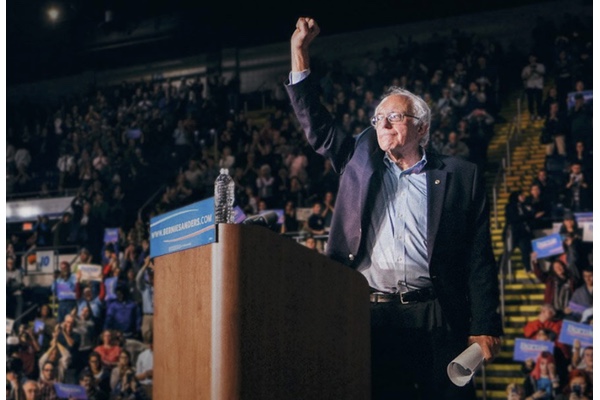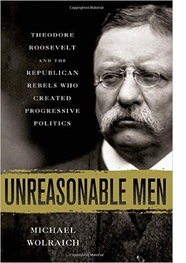Why Paul Krugman’s Wrong About Bernie Sanders

Paul Krugman may be a terrific economist, but he should study his history. In a trenchant New York Times column titled “How Change Happens,” Dr. Krugman asserts that legislative change requires “hardheaded realism” and “accepting half loaves.” Dismissing presidential candidate Bernie Sanders’s uncompromising idealism as “happy dreams” and “destructive self-indulgence,” he asks rhetorically, “When has their theory of change ever worked? Even F.D.R., who rode the depths of the Great Depression to a huge majority, had to be politically pragmatic, working not just with special interest groups but also with Southern racists.”
 But
F.D.R. offers a poor parallel to the political situation today.
Democrats dominated Congress during his 12-year tenure with
supermajorities that sometimes surpassed 75 percent. Krugman is
correct that F.D.R. compromised some elements of his agenda, but
he compromised from a position of strength, and most of his
landmark New Deal proposals passed with large majorities.
But
F.D.R. offers a poor parallel to the political situation today.
Democrats dominated Congress during his 12-year tenure with
supermajorities that sometimes surpassed 75 percent. Krugman is
correct that F.D.R. compromised some elements of his agenda, but
he compromised from a position of strength, and most of his
landmark New Deal proposals passed with large majorities.
For a far better parallel, Krugman should have considered the other President Roosevelt. Many Americans remember Theodore Roosevelt as a fighter who forced his will on a recalcitrant Congress, but he was an extremely pragmatic president. “When any public man says that he ‘will never compromise under any conditions,’ ” he wrote in 1900, “he is certain to receive the applause of a few emotional people who do not think correctly… but some distance he must go if he expects to accomplish anything.”
And compromise he did. In the early 1900s, two very powerful, very conservative Republicans, Senator Nelson Aldrich of Rhode Island and House Speaker Joseph Cannon of Indiana, ruled the Capitol. Even though T.R. hailed from the same party, they used their power to stifle his reform proposals in congressional committees. Unable to pass any legislation without their help, T.R. compromised from a position of weakness, allowing his proposals to be diluted to the point of inadequacy. “I love a brave man,” complained a disappointed Senate ally, “I love a fighter, and the President of the United States is both on occasion, but he can yield with as much alacrity as any man who ever went to battle.”
Because of congressional obstruction, T.R.’s legislative legacy is sparse for such an iconic president. He achieved a few landmark bills, including the Antiquities Act, the Pure Food & Drug Act, and the Panama Canal Act, but compared to his colleagues on Mount Rushmore or his illustrious cousin, T.R.’s pragmatism did not achieve much serious change. He is remembered more for his executive actions, including anti-trust lawsuits and environmental conservation, which he pursued precisely because of his legislative impotence—just like President Obama.
In my book, Unreasonable Men: Theodore Roosevelt and the Republican Rebels Who Created Progressive Politics, I contrast T.R.’s pragmatic approach with the uncompromising idealism of another progressive Republican, Senator Bob La Follette of Wisconsin. “Fighting Bob” was the Bernie Sanders of his day, a fierce ideologue prone to grandstanding filibusters and quixotic presidential campaigns. “In legislation no bread is often better than half a loaf,” he argued. “Half a loaf, as a rule, dulls the appetite, and destroys the keenness of interest in attaining the full loaf.”
T.R. couldn’t stand him. “La Follette impressed me as a shifty self-seeker,” he wrote. “[H]is real motives seemed to be not to get something good and efficient done, but to make a personal reputation for himself by screaming for something he knew perfectly well could not be had.” After La Follette filibustered Aldrich’s pro-Wall Street banking bill for a record-breaking 18 hours, Roosevelt groused, “Congress is ending with a pointless and stupid filibuster by La Follette. It is sheer idiocy for the Senate to permit such silly rules as will allow this kind of filibuster.”
But La Follette also had a strategy for creating political change. Recognizing that Congress would never pass substantive reforms under conservative control, he made it his mission to overthrow Senator Aldrich and Speaker Cannon and to create a truly progressive congress that would pass “not one or two mangled bills a session, but all the legislation we need.” His seemingly pointless filibusters, amendments, and presidential campaigns were carefully designed to publicize his ideas in order to nurture a national movement.
Contrary to Paul Krugman’s blithe assertion that political grandstanding cannot “persuade the broad public to support a radical overhaul of our institutions,” La Follette’s strategy was extraordinarily effective. T.R. left office in 1908 and was succeeded by his friend William Taft, another pragmatic Republican who allowed Aldrich and Cannon to gut his reforms. While T.R. took an extended trip to Africa and Europe, La Follette and a small band of likeminded Republicans mounted a political insurgency against the leaders of their own party. Reform fever swept the country, toppling Aldrich and Cannon and filling the halls of the Capitol with politicians promising radical change. Today we remember this movement by the name La Follette gave it: the Progressive Movement.
In the end, T.R. came round to La Follette’s way of thinking. When he returned from his travels, he found the country transformed. Absorbing the new ethos, he declared himself a progressive and ran for president in 1912, employing the kind of radical, uncompromising rhetoric that he had formerly decried. He muscled out La Follette’s campaign and challenged Taft for the Republican nomination. When the party establishment rebuffed him, T.R. bolted the convention and founded the National Progressive Party, popularly known as the “Bull Moose” party.
So successful was La Follette’s movement that Woodrow Wilson, formerly a conservative Democratic, also appropriated the progressive label and promoted an agenda of radical change. The three-man race between Wilson, T.R., and Taft was like a contest between Bernie Sanders, Elizabeth Warren, and Jeb Bush. Wilson won the presidency, and the conservatives were routed from Congress, finally achieving La Follette’s dream.
The new congress was among the most legislatively productive in American history. Over the next eight years, a bipartisan progressive coalition established income taxes, labor laws, women’s suffrage, campaign finance reform, environmentalism, industrial regulation, the Federal Reserve, and other reforms that Paul Krugman holds dear. Like F.D.R., Woodrow Wilson did have to compromise some elements of his agenda, but he compromised from a position of strength and achieved the kind of radical overhaul of our institutions that Krugman calls “happy dreams.”
Krugman is correct that as president, Bernie Sanders would get nowhere with the current Republican congress, but neither would Hillary Clinton. Just ask Barack Obama, who has spent the past five years getting nowhere with Congress despite repeated attempts to compromise. Bernie Sanders and his supporters do not deny this reality, but they do not accept the political status quo as permanent. By championing ambitious, undiluted reforms, they intend to galvanize a new Progressive Movement that will sweep the obstructionists from the Capitol. Then and only then will a progressive president be able to compromise from a position of strength to solve the nation’s pressing problems.
And that, Dr. Krugman, is how change happens.